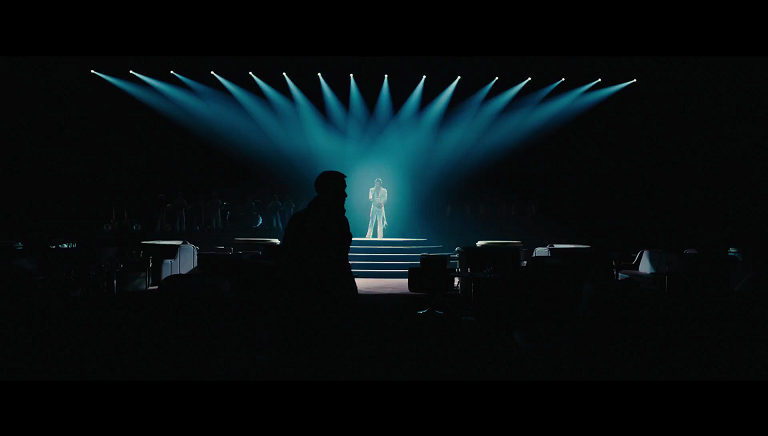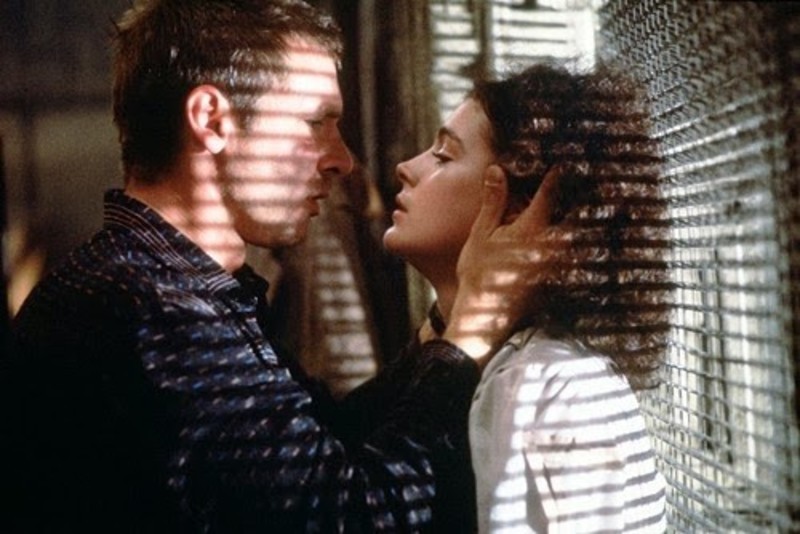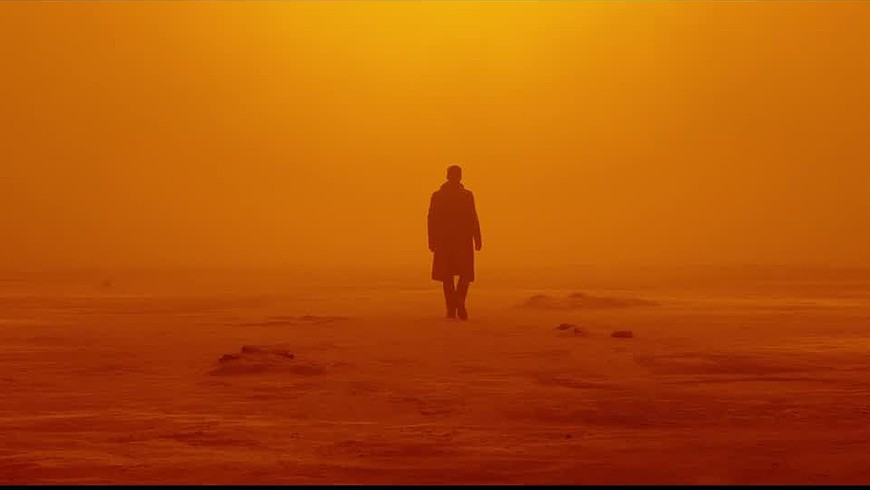Becoming A Blade Runner
Dicle Naz Tohumcu
Denis Villenueve's 2017 sci-fi fim Blade Runner 2049 brought the Blade Runner world back 35 years later. In the film, young Blade Runner "K" discovers a secret that will make him encounter the former Blade Runner "Rick Deckard", whom we first met in Blade Runner (Scott, 1982). I want to examine the stages of K's journey to meet Deckard: att first believing that Deckard is his father and then accepting that he is not, creates different phases of Deleuze and Guattari's "hybrid" definition for K's identity.
This year’s sci-fi film Blade Runner 2049 (Villenevue, 2017) brought the Blade Runner world back35 years later. In the film young Blade Runner “K” discovers a secret that will make him encounter the former Blade Runner “Rick Deckard” , whom we first met in Blade Runner (Scott, 1982). In this paper I am going to examine how stages of K’s journey to meet Deckard create different phases of Deleuze and Guattari’s “hybrid” definition for his identity. For this investigation, I am going to look at Teressa Rizzo’s work on Alien Series, The Alien series: Alien-becomings (Rizzo, 2004). For investigating how this journey directs K’s process of identifying himself according to Lacanian psychoanalysis approach, I am going to look at Fighting for Father: Fight Club as Cinematic Psyhcosis (Guntz & Fentz, 2010).
In the first sequence of the film K goes after and hunts down an older model replicant. After succesfully completing his mission, he finds a fresh plucked yellow flower on the ground. Their unit discovers that meters deep from the place this flower marked, there is a box full of bones. By the presence of the bones they identify that the owner of these bones was pregnant when she died. Strangely enough, they find a serial number which proves this woman was a replicant. To track the trace of this replicant, K goes to Wallace Corporation where they archive every possible identity records of the replicants and they also keep old Tyrell Corporation’s records. K walks through Wallace Corporation with Wallace’s right hand, Luv. Light follows their movement from the beginning of the first scene when K enters the data library until they stop in front of the door that Wallace keeps old Tyrell records. The lightning creates light and dark lines on the wall. When discussing silent film of the 1920s, Deleuze distinguishes between French impressionist cinema lighting—in which darkness is simply the absence of light, or light at degree zero—and German expressionist cinema lighting, in which darkness is a contrasting, negative principle, always engaged in a dialectical battle against light (Cinema 1, 40- 55). In this case we can assume that in these scenes lightning and darkness are in a dialectical battle. Despite the narrative, in this scene K finds out the owner of the bones, Rachael. This scene clearly shows how trapped K is in this visit and how it is impossible for him to follow his past or any other replicant’s. There are only names and serial numbers and the past doesn’t exist.

In Blade Runner (Scott, 1982) Rachael hopes to have a child and become a human. She believes that she has a soul. Teressa Rizzo’s suggestions on character Call in Alien Resurrection (Jeunet, 1997), who is an android programmed to have human emotions, is a suitable analysis for Rachael’s situation, too. Rizzo suggests that Call despises her hybrid body and pretends to be human. Her desire to come into contact with human durations has introduced her to human subjectivity, ego, moral codes and organizations diminishing her capacity to act. It is not until she has accepted her hybrid body that she is able to be effective (Rizzo, 2004). Once Rachael meets Deckard, the one who is able to immediately identify her, she finally accepts herself and her hybrid body and in fact she can even give birth to a child which is a creation of her and Deckard’s reproduction.
In Blade Runner 2049, K tells the only memory that he remembers from his childhood; the one when he hides a wood horse from the boys who chase him. Later this memory leads him to where this event takes place; an orphanage. He finds out this horse given to him by his father, Deckard. After checking the genes of the bones and finding out the child’s DNA codes, K sees that there are two different records for this; one boy and one girl. Only later when he meets the anarchist replicants he gets that it is not a special memory for him and it is created by someone else and the other replicants also have this memory. Thus, Blade Runner 2049 introduces us with identity crises of the replicants much later than Blade Runner does. Maybe, it is because K is a loner and he doesn’t have the kind of relationship that Deckard had with Rachael once upon a time. K is a man who has a relationship with a Wallace product. If we speak about casting, this isn’t the first time Gosling has been casted as a man who is in a relationship with a female bodied product. “Joi” who could be simply defined as female during film is also shown with her giant moving holograms in the streets. In Lars and the Real Girl (Gillespie, 2007), character Lars who is played by Gosling falls in love with a sex doll. Likewise, this time his character has a soulful relationship with this woman, Joi. Although film itself defines her as a product, it assigns her as a cyborg who could engage with people.

Undoubtley, one of the main controversial scenes from the film is the one where Wallace brings a copy of Rachel for Deckard. At first, this copy appears almost like the one in the first film, although Deckard is naturally older than he was in those days. Deckard looks at Wallace and says that Rachel’s eyes were green. Considering the fact that the Blade Runners separate replicants from humans scientifically by their eyes, Deckard’s emotional reactions and recognition in this scene shows his relationship with Rachel was intimate.
After finding out the truth about his memory, K gives up having a father and accepts its creator. He goes to see his creator and les Deckard meet his daughter. Blade Runner (Scott, 1982) starts with an interrogation of a replicant. Officer asks the replicant the things he remembers about his mother and while replying him with the question, “About my mother?”, the replicant kills the officer.
According to (Gunn&Frentz, 2010), Understood as a failure to accept limits or internalize one’s identity, psychosis is thus a kind of infinite, narcissistic regress prior to sexual differentiation, prior to the object-choice of secondary identification, a failure to be ‘‘cut’’ or ‘‘castrated’’ by the symbolic order such that one can get some distance between objects and the names for those objects. Consequently, there is no ‘‘difference’’ in psychosis. The failure to complete the Oedipus complex thus results in a psychosis that is neither homosocial nor homoerotic, despite appearances: psychosis is simply homohomohomo-ad infinitum, as the individual has no sense of (m)Other, only an undifferentiated whole, an unmediated sense of self without limits.
K struggles about the same question with that replicant in the first film. At first he lives without having a sense of (m)Other and he fails to accept his identity’s limits. K’s journey leads him to find his own roots. First he believes that Rachel is his mother and after finding out that she is not, he tries to replace her. In this case, rather than psychosis, this crisis gives him a mission to accomplish, a meaning and a goal for his life. After finding out that this memory is created by the daughter who he once thought he himself was, he replaces her with the god. He used to see himself as a god, but now he is not because he is created by someone else and he chooses to serve to his own god, the one who created his memories. By discovering that Deckard isn’t his father, he becomes one with other replicants and becomes a part of larger assemblage. According to Rizzo (2004), by exploring the themes of mutation, hybridity and transformation, the film produces bodily sensations that make the viewer aware of the way the human body is always a part of larger assemblages and not something totally distinct.

Another 2017 sci-fi movie Ghost in the Shell (Sanders, 2017) has a weird similarity with Blade Runner 2049. In the beginning of the film the lead character Major Motoko dies. She is saved and her body, mind and soul are put into a ghost body. She remembers a fire from her past; a fire that she is saved from. Later it turns out that she and a group of anarchists whom she is with were attacked by the government in that fire. So this was a collective memory for their community. Later we learn that the other ghost character in the film, Koze was also in that fire and they were lovers back then. This fire image is also present in the minds of the anarchist replicants in Blade Runner 2049. This helps me question what happened to the other orphans. Couldn’t some of them be like K and other’s creator? Couldn’t one of them be a child of a replicant? I assume, the film suggests they could, by giving this memory as a collective memory. There is no memory which belongs to only one. Where Deckard and K fight they enter a concert hall of this old abandoned hotel, the holograms of Elvis, Sinatra and other icons are on the stage. These scene says that the world of these icons are in the past now, being an icon is in the past and it is not possible in this world to have an identity which is that much defined.

I assume that when it comes to the end of the film, K in Blade Runner 2049 becomes a great representation for a hybrid body. He will never know where he comes from and therefore he would never be able to define himself with his past. After a journey full of identity crisis, ending of the film assigns that his indefinable identity could supply him and other replicants with limitless hybridization.
WORKS CITED
Deleuze, G. (1986). Cinema 1: The Movement-Image. Trans. Hugh Tomlinson and Barbara Habberjam. University of Minnesota Press.
Gillespie, C. (Director). (2007). Lars and the Real Girl. Metro-Goldwyn-Mayer
Gunn&Fentz. (2010). Fighting for Father: Fight Club as Cinematic Psyhcosis. Western Journal of Communication.
Rizzo, T. (2004). The Alien series: Alien-becomings. Women: A Cultural Review, 15.3.
Sanders, R. (Director). (2017). Ghost in the Shell. DreamWorks.
Scott, R. (Director). (1982). Blade Runner. The Ladd Company.
Villeneuve, D. (Director). (2017). Blade Runner 2049. Warner Bros.
next
article Twitter Google Plus Facebook
